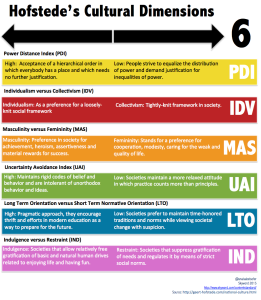16 Dimension of Culture
NOR AZMA BINTI RAHLIN
Geert Hofstede’s Cultural Dimensions Theory
Hofstede explained his findings using six different cultural dimensions-the preferences for one state of affairs over another that distinguish countries (rather than individuals) from each other.
Hofstede included six key aspects of national culture country comparison scales, including:
- the power distance index (PDI),
- individualism vs. collectivism (IDV),
- masculinity versus femininity (MAS),
- uncertainty avoidance index (UAI),
- long term orientation versus short term normative orientation (LTO), and
- indulgence versus restraint (IVR).
The PDI describes the degree to which authority is accepted and followed.

International students and business professionals have used this framework to understand how cultural aspects such as individualism or uncertainty avoidance can influence a negotiation. In practice, it has served as a base to set expectations when addressing a multicultural audience.
Trompenaars’ model of national culture differences
“Trompenaars’ Cultural Dimensions” by Mizta D is licensed under CC BY-SA 3.0
Fons Trompenaars is another researcher who came up with a different set of cross-cultural measures. These are his seven dimensions of culture (The seven dimensions of culture, n.d.):
- Universalism vs. particularism: the extent that a culture is more prone to apply rules and laws as a way of ensuring fairness, in contrast to a culture that looks at the specifics of context and looks at who is involved, to ensure fairness. The former puts the task first; the latter puts the relationship first.
- Individualism vs. communitarianism: the extent that people prioritize individual interests versus the community’s interest.
- Specific vs. diffuse: the extent that a culture prioritizes a head-down, task-focused approach to doing work, versus an inclusive, overlapping relationship between life and work.
- Neutral vs. emotional: the extent that a culture works to avoid showing emotion versus a culture that values a display or expression of emotions.
- Achievement vs. ascription: the degree to which a culture values earned achievement in what you do versus ascribed qualities related to who you are based on elements like title, lineage, or position.
- Sequential time vs. synchronous time: the degree to which a culture prefers doing things one at a time in an orderly fashion versus preferring a more flexible approach to time with the ability to do many things at once.
- Internal direction vs. outer direction: the degree to which members of a culture believe they have control over themselves and their environment versus being more conscious of how they need to conform to the external environment.
Source adopted from:
Geert Hofstede (1996) “Riding the waves of commerce: a test of Trompenaars’ “model” of national culture differences”, in: International Journal of Intercultural Relations 20(2): p. 189-198
Hampden-Turner, C. (1997) Riding the Waves of Culture

